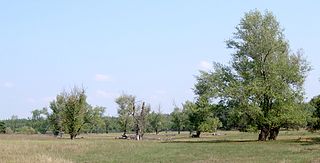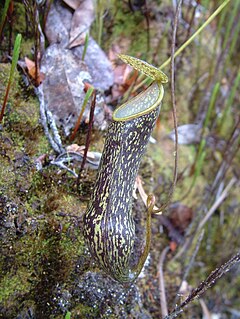Related Research Articles

The substantia nigra (SN) is a basal ganglia structure located in the midbrain that plays an important role in reward and movement. Substantia nigra is Latin for "black substance", reflecting the fact that parts of the substantia nigra appear darker than neighboring areas due to high levels of neuromelanin in dopaminergic neurons. Parkinson's disease is characterized by the loss of dopaminergic neurons in the substantia nigra pars compacta.

Sambucus is a genus of flowering plants in the family Adoxaceae. The various species are commonly called elder or elderberry. The genus was formerly placed in the honeysuckle family, Caprifoliaceae, but was reclassified as Adoxaceae due to genetic and morphological comparisons to plants in the genus Adoxa.

Pinus nigra, the Austrian pine or black pine, is a moderately variable species of pine, occurring across southern Mediterranean Europe from the Iberian Peninsula to the eastern Mediterranean, on the Anatolian peninsula of Turkey, on Corsica and Cyprus, as well as Crimea and in the high mountains of Northwest Africa.

Populus nigra, the black poplar, is a species of cottonwood poplar, the type species of section Aigeiros of the genus Populus, native to Europe, southwest and central Asia, and northwest Africa.

Linea nigra, often referred to as a pregnancy line, is a linear hyperpigmentation that commonly appears on the abdomen. The brownish streak is usually about a centimeter (0.4 in) in width. The line runs vertically along the midline of the abdomen from the pubis to the umbilicus, but can also run from the pubis to the top of the abdomen.

Brassica nigra, or black mustard, is an annual plant cultivated for its black or dark brown seeds, which are commonly used as a spice. It is native to tropical regions of North Africa, temperate regions of Europe, and parts of Asia.

Salix nigra, the black willow, is a species of willow native to eastern North America, from New Brunswick and southern Ontario west to Minnesota, and south to northern Florida and Texas.

Sambucus nigra is a species complex of flowering plants in the family Adoxaceae native to most of Europe and North America. Common names include elder, elderberry, black elder, European elder, European elderberry, and European black elderberry. It grows in a variety of conditions including both wet and dry fertile soils, primarily in sunny locations. The plant is a very common feature of hedgerows and scrubland in Britain and northern Europe, but is also widely grown as an ornamental shrub or small tree. Both the flowers and the berries have a long tradition of culinary use, primarily for cordial and wine. The Latin specific epithet nigra means "black", and refers to the deeply dark colour of the berries.

The Galápagos tortoise complex or Galápagos giant tortoise complex is a species complex of 15 very large tortoise species in the genus Chelonoidis. They are the largest living species of tortoise, with some modern Galápagos tortoises weighing up to 417 kg (919 lb). With lifespans in the wild of over 100 years, they are one of the longest-lived vertebrates. Captive Galapagos tortoises can live up to 177 years. For example, a captive individual, Harriet, lived for at least 175 years. Spanish explorers, who discovered the islands in the 16th century, named them after the Spanish galápago, meaning "tortoise".
The Wych Elm cultivar Ulmus glabra 'Nigra', commonly known as the Black Irish Elm, was found in the Kilkenny area c.1770 by the father of nurseryman John Robertson of Kilkenny, who later cultivated it. Robertson stated that he had not seen the form outside Ireland. It was listed by Loddiges (1830) as Ulmus nigra, and described by Loudon in Arboretum et Fruticetum Britannicum (1838), as Ulmus montana nigra. 'Nigra' is not mentioned in either Elwes and Henry's or Bean's classic works on British trees.

Nepenthes nigra is a tropical pitcher plant known from a number of mountains across Central Sulawesi, where it grows at elevations of 1500–2700 m above sea level. The specific epithet nigra refers to the dark colouration of the pitchers and stem. The species is closely related to N. hamata and N. tentaculata.
Theocridini is a tribe of longhorn beetles of the subfamily Lamiinae. It was described by Thomson in 1858.
Planodema is a genus of longhorn beetles of the subfamily Lamiinae, containing the following species:
Planodema flavovittata is a species of beetle in the family Cerambycidae. It was described by Stephan von Breuning in 1947.
Planodema freyi is a species of beetle in the family Cerambycidae. It was described by Stephan von Breuning in 1955.
Planodema similis is a species of beetle in the family Cerambycidae. It was described by Stephan von Breuning in 1958.
Planodema congoensis is a species of beetle in the family Cerambycidae. It was described by Stephan von Breuning in 1942.
Planodema griseolineata is a species of beetle in the family Cerambycidae. It was described by Stephan von Breuning in 1938, originally under the genus Docus.
Planodema leonensis is a species of beetle in the family Cerambycidae. It was described by Stephan von Breuning in 1936.
Planodema granulata is a species of beetle in the family Cerambycidae. It was described by Per Olof Christopher Aurivillius in 1928. It is known from South Africa, Somalia, and Zimbabwe.
References
- ↑ BioLib.cz - Planodema nigra. Retrieved on 8 September 2014.